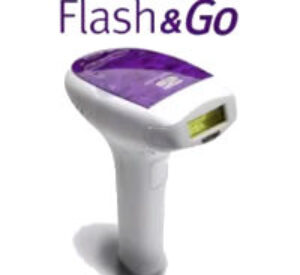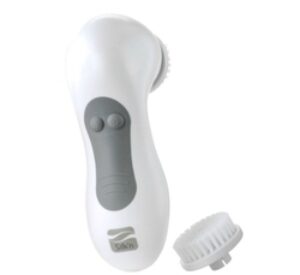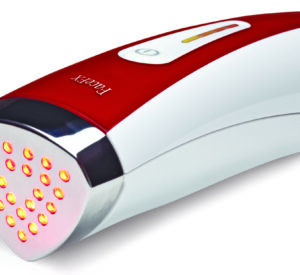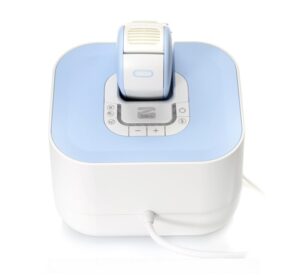This is an article about the Tria Hair Removal Laser, which is designed to provide consumers with smooth, hairless skin from the comfort and privacy of their own home. The device utilizes FDA-cleared technology to give users safe, private hair removal sessions that will deliver complete results in as little as about three months of use. Tria allows its consumers to “See Beauty in a New Light.”
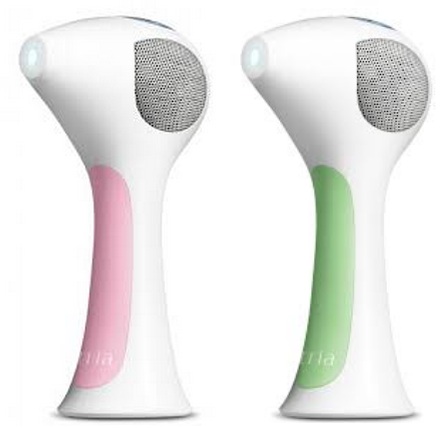
The Tria Hair Removal Laser is available in Blush, and Green.
Product Overview
The Tria Hair Removal Laser 4X is an at-home laser hair removal device that is designed to provide users with permanent hair removal from the comfort and privacy of their own home. It utilizes very similar technology to that used in professional clinics for the last several decades. Because of the extensive testing and scientific research that has proven its effectiveness at removing unwanted or unsightly body hair, the diode laser technology of the device has been cleared by the FDA.
It has a cordless device with a digital display which shows the treatment setting, the number of pulses emitted, and the remaining battery charge on the device. It is available in two pastel colors: Pink (Blush), and Green. Because of the technology of the device, users are not required to wear safety goggles during a treatment session, unlike with some other similar devices. The device is backed by a 90-Day Money Back guarantee that promises users a full refund if they are not satisfied with the results.

The display of the Tria Hair Removal Laser.
How the Tria Hair Removal Laser is Used
Using the Tria Hair Removal Laser 4X is very simple, and can be performed safely by just about anyone. Because of the laser diode technology utilized within the device, users of the Tria Laser do not have to wear safety goggles. Following the steps below, users can safely get the permanent hair removal that they desire.
The skin should be prepared for treatment by cleaning, shaving, and drying the areas that are to be treated.
Turn the device on by pressing the Power button on the top of the Tria hair removal device.
Find the skin sensor at the base of the device (it is a red light). Hold the skin sensor against the part of the skin that is going to be treated, and wait for the device to unlock. If the skin sensor determines that the skin is too dark to be treated, the device will not be unlocked, and no pulses will be emitted from the device. This is a safety feature built-in to the device for the user’s protection.
1. Choose the treatment level to treat the skin. Starting with a lower setting (1 or 2) is best. Continually increase the power level of the Tria until it is at the highest level that can be tolerated comfortably. Note: Higher treatment settings will yield faster results.
2. Hold the laser tip flat against the skin until two beeps are emitted from the device (this is when the device will deliver treatment).
3. Users should expect to feel a sensation similar to that of popping a rubber band against the skin. Some users may also feel a warm pricking on the skin. These are completely normal.
4. Move the laser tip to a new part of the skin that overlaps the previously treated area by about ¼ of an inch.
5. Repeat this process until the entire region is treated.
6. The device is turned off by holding down the Power button on the top of the device.
7. Repeat one time each week, for about three months.
It is recommended that users apply Tria’s SmoothStart Calming Gel to the skin before and after each treatment to help speed the treatment process. This product also contains anti-inflammatory properties that help relax the skin after each treatment session.
Treatment of each part of the body will vary depending on the size of the area. However, users should expect to spend 2 to 3 minutes treating the upper lip, 5 to 10 minutes treating areas about the size of the hands, feet, shoulders, bikini line, and underarms, and about 20 to 30 minutes treating the upper legs and lower legs.
An information and instructional video has been provided for consumers who are interested in learning more about the Tria Hair Removal Laser.
top of page
Duration of Treatment with Tria Laser Hair 4X
As with most other laser or light-based hair removal products, such as lasers or IPL laser treatment, the duration of treatment of the Tria hair removal device will take about three months. However, noticeable results are achieved by most after just two treatments.
After two to three months of treatment, reviews indicate the hairs that grow will be much lighter and finer. Much more significant results will be noticed on areas that typically grow much thicker hair.
After three months of treatments, the deactivated hair follicles will no longer grow hair. After this period, Tria should only need to be used for maintenance.
top of page
Who Can Use the Tria Hair Removal Laser?
There are a large number of women and men who can safely use the Tria Laser 4X. However, as with many other laser or light-based hair removal systems, there are some individuals who cannot use the device safely. Individuals with naturally dark skin tones cannot safely use the Tria hair removal device. However, individuals with fair, ivory, beige, or light brown skin can use the device. For any person who may be concerned about whether or not they can safely use the device, the Tria Hair Laser 4X features a built-in skin sensor that determines whether or not the skin can be treated safely. This takes the guess-work out of the hair removal process.
There are also individuals with varying hair color who will benefit most from the Tria hair removal laser. Individuals with light brown, medium brown, dark brown, or black hair body hair will achieve results with the device. However, individuals with white, grey, red, or light blonde hair are not likely to experience positive results with the Tria hair removal laser 4X. Outlined below are skin tones and hair colors that can be treated safely and effectively by the Tria hair removal system.

Skin tones and hair colors that are safe and effective with the Tria Hair Removal Laser.
top of page
Parts of the Body that can be Treated with Tria Hair Laser 4X
Users of the Tria hair removal system can use the device to get rid of unwanted body hair just about anywhere on the body. The upper lip, arms, legs, underarms, bikini area, chest, and back can all safely be treated using the Tria laser.
top of page
Safety Features of the Tria Hair Removal Laser
The Tria hair removal device has been designed with several safety features that help make the laser hair removal system one of the safest on the market. As with many other home laser hair removal devices, the Tria hair removal laser comes with a built-in skin tone sensor on the bottom of the device. The skin tone sensor of the Tria is intended to be utilized before a hair removal session is begun. It automatically measures the user’s skin tone to determine whether or not the device can be used safely on the skin. If the device determines that the user’s skin is too dark for safe treatment, it will not unlock, and a hair removal session cannot commence. For individuals who are questioning whether or not they should purchase the device because they have relatively dark skin, they should be reminded that the company provides their consumers with a Risk Free 90-Day Money Back Guarantee. This means that if they purchase the device and it cannot be used on their skin, they can return the device for a full refund.
Another safety feature of the Tria Hair Removal Laser 4X is the device’s pulse counter. The device comes with a User Manual that informs the user of the recommended pulse count on each part of the body. The User Manual, as well as the built-in pulse counter, allow the user to know the perfect number of pulses to use on each part of the skin. This allows them to use the device safely and effectively.
top of page
Side Effects of the Tria Hair Removal Laser
Because of the laser diode technology utilized inside the Tria Hair Removal Laser 4X, there are very few side effects that are generally reported by users. Some of the most common side effects of treatment include some mild redness that usually disappears after no more than 24 hours. This side effect, however, is very common amongst at-home laser hair removal products.
Besides this mild redness, there are very few other negative side effects. During treatment, users of the Tria laser should expect to feel some light tingling. The sensation of a rubber band being popped against the skin is another common experience reported by users.
top of page
Replacement Parts of the Tria Hair Removal Laser
Unlike many other home laser hair removal products, the Tria Hair Removal Laser 4X does not utilize any replacement bulbs or other replacement parts. This makes the cost of the device closer to the true cost. Similar products will require relatively expensive bulbs or cartridges that need to be replaced after a certain number of pulses have been administered.
top of page
Technology of the Tria Laser Hair Removal System
The Tria hair removal system is fairly similar to other home laser hair removal products. However, rather than using Intense Pulsed Light (IPL technology), the device uses diode laser technology, which is almost identical to the technology that has been used in professional hair removal salons for many years.
The diode laser technology that is found in the Tria hair removal device is designed to disable the growth of actively growing hairs. Because not all hairs are growing all the time, only select hairs will be targeted during a given treatment session.
Phases of Hair Growth
During any given time, the hairs on the body are either in the Anagen, Catagen, or Telogen phases of growth.
The anagen phase of hair growth is the active stage of growth. During this phase, hair is connected to its follicle, and it is actively growing.
The catagen phase of hair growth is also commonly referred to as the transitional phase of hair growth. Hair in the catagen phase is no longer actively growing, and the hair begins to separate from the root.
The telogen phase of hair growth is also known as the resting phase of growth. Hair in the telogen phase is not connected to its root. As a result, no growth can occur.
Hairs spend an extended period of time in each particular growth phase. Additionally, there is no surefire way to know which phase of growth a hair is currently in. This is why numerous treatments with the Tria are necessary in order to see complete results.
As opposed to some other products, such as the Silk’n SensEpil, evoDerma LUMI, and others, the diode laser technology is more effective at selectively targeting the hair follicle, rather than the melanin of the hair (which is also found in the skin). This means that users of the Tria hair removal device will often experience fewer adverse side effects related to skin discomfort.
top of page
top of page
Tria Before and After Photos
Individuals who wish to share their success (or lack of success) with the Tria hair removal product can E-mail their stories and photos to admin@youreviewit.com.
top of page
Cost of the Tria Hair Removal Laser
The Tria Hair Removal Laser 4X retails for $449. This is very comparable to many of the other similar home laser hair removal products available on the market today. However, with no replacement parts necessary, the long-term cost of the Tria hair removal system can end up being much less than many other similar products.
top of page

